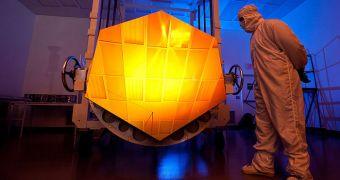The Senate version of the 2012 fiscal year appropriation bill was marked yesterday, September 14, a huge milestone for the endangered NASA James Webb Space Telescope (JWST). The House version of the same act proposed that the project be terminated despite obvious progress.
When that announcement was first made, the international scientific community reeled and shock and then battered the American government with numerous open letters, petitions and phone calls to stop this grave error from being carried out.
Individual citizens were also encouraged to write to their respective Congressmen, showing their support for the endeavor that will create the world's largest, most advanced space observatory ever.
Under the Senate version of the bill, the JWST will receive the necessary funds over the next few years, with a planned 2018 launch data being strongly considered. Though initially scheduled to launch a lot sooner, poor management led to significant cost overruns that brought the telescope into focus.
“In a spending bill that has less to spend, we naturally focus on the cuts and the things we can’t do. But I’d like to focus on what we can do,” CJS Subcommittee Chairwoman Barbara Mikulski explained.
“The bill invests more than $12 billion in scientific research and high impact research and technology development, to create new products and new jobs for the future,” the Congresswoman added.
However, she did urge NASA, the National Oceanic and Atmospheric Administration (NOAA), the National Science Foundation (NSF) and the National Institutes of Standards and Technology (NIST) to be more watchful of the way they spend their taxpayer money.
The official said that monitoring and controls will be tighter than ever next year, due primarily to the precarious situation of the US economy, and the need to reduce government spending. The bill awards the National Aeronautics and Space Administration a budget of $17.9 billion for 2012.
That represents a 2.8 percent reduction – the equivalent of $509 million – from 2011 levels. The rest of the money are divided in a balanced manner science, aeronautics, technology and human space flight investments, Universe Today reports.
The Orion Multi-Purpose Crew Vehicle (MPCV), the newly-announced, heavy-lift Space Launch System, and ongoing commercial crew development programs are also supported throughout 2012.
Before we can celebrate however, the budget still needs to be approved by the full appropriations committee, and then go through the Senate for a vote. After this is done, the revised form will be reconciled with the House budget for a final, applicable version.
Still, the fact that the Senate did not dismiss the JWST project is encouraging news, so one cannot stop to hope. Keep a close eye on this space for future developments.

 14 DAY TRIAL //
14 DAY TRIAL //